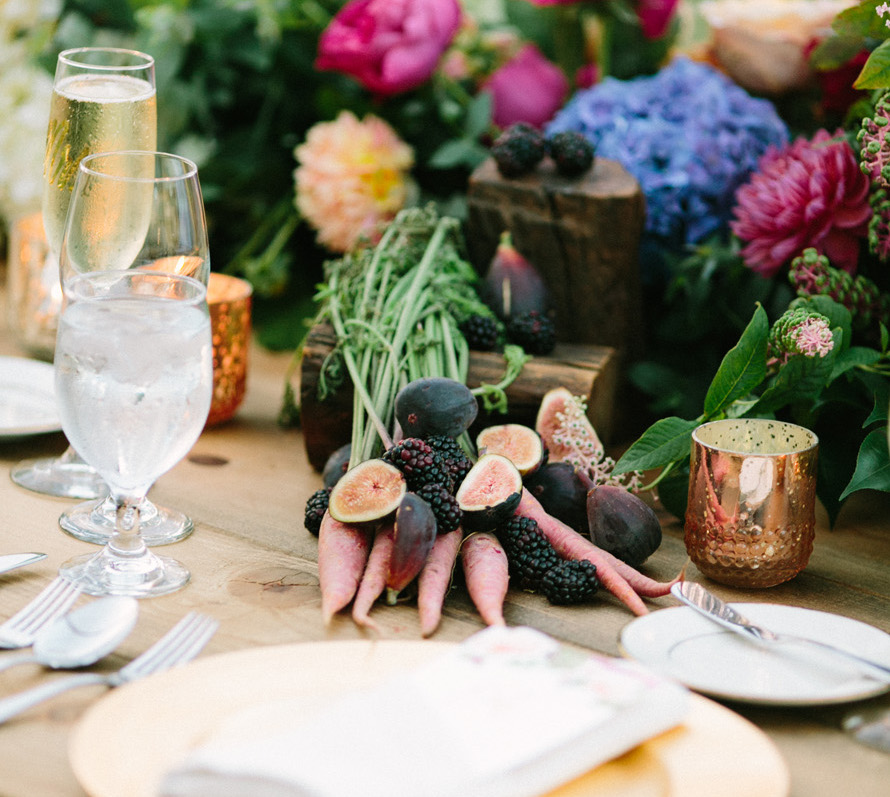Fresh, Local & Fantastic Cuisine
By: Kristen Castillo
It may be a buzzword in the culinary industry, but Farm to Table is an established style that’s good to eat and good for the environment too.
So what is farm to table all about? It’s a movement to eat fresh, local and sustainable foods. That means planting, growing and consuming fruits and vegetables that are from the community. So eating strawberries from Carlsbad is the ideal, while trucking in berries from Arizona or oranges from Florida isn’t.
The benefits are obvious – healthy, fresh food that comes from and supports the local community and economy. Plus you’ll enjoy seasonal foods throughout the year instead of relying on food that was once frozen and may be full of preservatives.
Farm to Table Appeal
“This movement is great because you know exactly where your food is coming from,” says Christie Gowdy of
Culinary Concepts. “You know you are getting fresh, organic produce in a variety of colors and flavors.”
“An interest in clean living and avoiding processed foods is driving the farm to table movement,” says Jason Howard from Feast On This.
“Local food is fresher, healthier and more nutritious,” he says. “By spending less time in transit from farm to plate, fewer nutrients are lost and less spoilage incurs. This results in better quality, taste and healthier options.”
Farm to table “puts the freshest in season produce in front of you,” says Eric Bauer,
corporate executive chef for
Festivities Catering, noting the concept, also called farm to fork grew in popularity in Northern California by chef and author Alice Waters of San Francisco’s Chez Panisse.
Quality Counts!
With a focus on quality food, farm to table can be a very selective and pricey. Still it’s often within budget since you’re using local, seasonal items.
“While mass imported crops are produced on a much larger scale, local farmers are often a smaller operation and incur more operating expenses,” says Howard. “Their crops are much smaller but, with this, come a superior product. Small farmers pay special attention and take much pride in their craft so they ensure everything is top quality.”
San Diego is home to many farms, which are happy to be part of the farm to table movement.
“For smaller events, it is common to see our kitchen team strolling local farmer’s market buying produce direct from the growers,” says Howard, noting Suzie’s Farm is “an industry favorite.” (Both Festivities Catering and Culinary Concepts source from Suzie’s too.)
Recently, Festivities Catering has also sourced Chino Farms, Crows Pass Farms, Schaner Farms, Weiser, Scarborough, McGrath and Gloria Tamai, while Culinary Concepts has used Stehly, Sun Grown Organics and Be Wise Ranch.
In addition to buying from local farms and produce companies, many farm to table caterers also source micro beers and wines from local breweries and wineries, respectively.
Rave Reviews
Typically farm to table menus are based on the time of year and seasonal selections. For a recent wedding at a San Diego-area park, Howard and his team catered a farm to table style brunch.
“We served local made per order omelets and waffles with assorted locally grown fruits, vegetables, nuts and homemade whip cream,” he says, noting they served local sparkling wine and local pureed fruits (purchased from a farmer’s market) at a bellini bar. “Guests enjoyed mixing and matching local peaches, watermelon and assorted berry purees.”
Farm to table caterers work with couples to create a custom wedding menu.
“We source as much as we can locally and within California but sometimes a couple are looking for something that isn’t in season here so we need to look elsewhere,” says Bauer. “In the end its really going the extra mile for the client and getting them exactly what they want to make the day perfect.”
Even if you can’t source the entire menu in a farm to table fashion, try to incorporate as many local and seasonal touches as possible.
What’s in Season in San Diego?
Source: Suzie’s Farm
Throughout the year in San Diego, you can find lettuce, spinach, Swiss chard, fennel and arugula. Still many items are at their peak during specific seasons.
Spring: Strawberries, onions, garlic, peas and artichokes.
Summer: Tomatoes, beans, peppers, zucchini, melons and summer squash.
Fall: Broccoli, peas, pumpkin, kale cabbage and cauliflower.
| Sample Farm to Table Menus |
|
Sample Summer Menu
Source: Festivities Catering
|
|
Appetizers:
Main Entrée:
Dessert:
Cocktail:
|
|
Sample Menu
Source: Culinary Concepts
|
|
Appetizers:
Main Entrée:
Vegetarian & Gluten Free Option:
Dessert:
|










